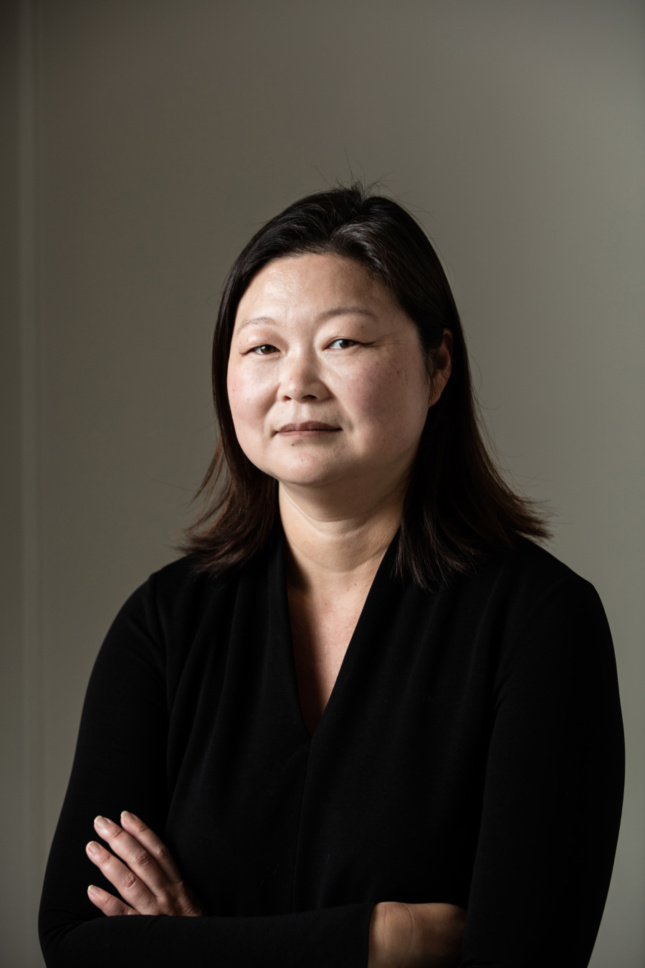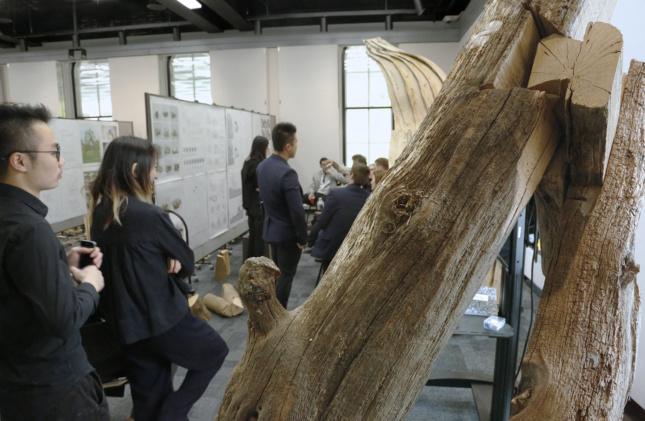J. Meejin Yoon is a cofounding principal of Höweler + Yoon Architecture and, since January 2019, the Gale and Ira Drukier Dean of Architecture, Art, and Planning at Cornell University. Previously, she was the head of the Department of Architecture at the Massachusetts Institute of Technology, where she was also a professor for 17 years.
Höweler + Yoon Architecture has won numerous awards, including the Progressive Architecture Award, the Audi Urban Future Award, and the Emerging Voices award from the Architectural League of New York. The firm has built around the world; projects currently under construction include the Memorial to Enslaved Laborers at the University of Virginia and a 20,000-square-foot corporate clubhouse in Chengdu, China.
Jack Balderrama Morley, AN’s managing editor, spoke with Yoon about the state of architecture in 2019, and where the profession can—and should—go from here.

The Architect’s Newspaper: What do you think are the biggest problems in the building industry and the architecture profession in the U.S. right now?
Meejin Yoon: I think many would say that the biggest design challenge of our time is climate change. But expanding that further, I would say that the critical question everyone in the field is asking is, what is the agency of architecture? Do architects have the kind of agency and ability to impact these big challenges?
Agency requires broad disciplinary knowledge so that the architect can lead and coordinate across disciplines in joined efforts to address the big environmental challenges of our time, issues around rapid urbanization, and those issues’ potential impact on social equity.
As a practicing architect, you come up against limits that you do not come up against within academia but these are productive in helping us frame and reframe broad questions related to agency. There are great examples of architects who, because of their social mission, are expanding beyond the traditional limits of professional practice, whether it is through developing internal research entities or turning their practices into non-profits, or partnering with NGOs and cities to address urban resiliency and adaptation questions.
Thinking about agency, one of the major social issues that has come up in architecture in recent years is the relationship between architects and the people who actually build the buildings. Do architects have a responsibility to address these labor issues?
I was thinking back on the most basic tenets of the profession of architecture. When we get our licenses, it’s very clear that the mandate of architecture is, at the most basic level, about health, safety, and welfare.
Your question reminds me that part of health, safety, and welfare is thinking through labor in a way that extends to every aspect of the building, including the means by which it is built. Of course, architects do not always get to make labor decisions, but clients do, and architects have an ability to impact labor by advocating for how important sound, ethical labor practices are. We can speak to the benefits of working with craftspeople who are adequately trained and fairly compensated for their work. Architects everywhere ought to be consistent in applying our mandate to decisions we make and influence from design through construction, and for the entire life of the building, so that we can work together toward a public good.
Throughout much of the 2010s, it looked like architecture and the tech industry were moving toward some kind of marriage: Bjarke Ingels and Michel Rojkind were recruited by WeWork, and Ingels and Thomas Heatherwick started working for Alphabet, Google’s parent company. This year, though, the Sidewalk Labs development in Toronto has come under intense criticism—its glossy architecture has been accused of “design-washing”—and WeWork looks to be on the verge of bankruptcy. More generally, skepticism has grown about companies like Tesla, Amazon, and Facebook. How do you see architecture relating to big tech from now on?
Historically, some of the most catalytic projects have been when design professionals work with industry. I’m thinking of IBM and the Eameses—when Charles and Ray Eames created the Mathematica exhibitions and the IBM Pavilion, they participated as designers in a disruptive moment.
In recent times—when Google and WeWork hire the Bjarkes and the Heatherwicks—it’s really exciting that these big tech industries are valuing design because they elevate design to the world at a scale that smaller companies cannot.
I don’t think designers should walk away from opportunities to help any entity with building questions, but rather exercise our agency and use our expertise. When these larger companies partner with architects and designers, I am hopeful because I think it’s not about design-washing at that point, it’s really about design transformation. When a big tech company rethinks workplace design, what a corporation could be or should be, or where headquarters are sited and located, and looks into the environmental footprint of some of these options, we want architects at the table.

On that note, the climate crisis is breaking into architecture discourse in a new way this year with professionals getting involved in a potential Green New Deal and the Extinction Rebellion. Do you see the profession talking about buildings’ effect on climate (and not just their response to it) in a way that goes beyond what has come before?
I think that climate change is the greatest design challenge of our time, and it’s a design problem that cuts across disciplines and scales, ranging from policy design to urban and ecological design, to transportation and building design, to land-use practices and individual consumption patterns.
I think this means we need to work in new ways. There are many parts of the profession that are built on productive, adversarial relationships, but I think productive tensions aren’t going to work at the scale of climate change design. It’s much more about strategic alliances that range from the speculative to the applied, to these large scale initiatives.
The scale of the problem is one that can’t be resolved solely incrementally with different tactics by different industries and professions. It needs large-scale, coordinated efforts.
Earlier this year, you wrote in Architect magazine: “We need to keep current and future generations of women from needing to take on both the rigorous work our field demands and the workarounds that allow them to do it. No one today should need to hide in a gutter in order to pursue, endure, and flourish in an industry that needs them more than ever.” What specific changes that you think schools or firms can make in the near future?
There is a perception of a kind of exclusiveness of the profession of architecture, and I think that breeds more exclusivity. The combination of the high cost of tuition and the low starting salary might deter many people, in particular those who are traditionally underrepresented, from pursuing both a degree and the profession. The discipline cannot afford to continue to exclude that much talent.
At Cornell, we have the Cornell Future Architect Award, and it’s an amazing program started by previous students, working with friends in New York City. The program supports the pipeline of underrepresented minorities into the field by providing scholarships for our introductory summer program that exposes upper-level high school students to architecture. We give eight to 12 scholarships for summer programs, and we see that having an impact on the number of students that are then exposed to the profession, are equipped to put a portfolio together, and can then apply not only to our program, but to architecture programs throughout the United States.
That’s the pipeline side. I would say one thing we could do as a profession is support and encourage leadership among women and minorities who go to work at firms. Increasing the diversity of people in decision-making positions at all levels of architecture practices, the building industry, construction industry, development, real estate is going to have only positive effects on the profession overall.
Switching gears a bit, this year, some of the giants of postmodernism (Stanley Tigerman, Charles Jencks, Robert Venturi) passed away as the movement’s bright colors, bold forms, and cheeky style are being embraced by the Instagram generation. What role do you see for postmodernism in the near future?
What was essential about postmodernism was that it offered a critique of the status quo and offered concrete alternatives.
What’s happening now is coming out of an extreme pluralism which values everything at the same level. And so, there’s no longer a kind of disciplinary discourse like before with the grays versus the whites. There was a productive value in that point-counterpoint debate.
I heard someone recently say, “Oh, the discipline has no problems—we’re in the era of the ‘post-problematic,’ where everything is possible and nothing is wrong.” I was surprised to hear that because I think our discipline has more challenges than ever: climate change, urbanization, equity. But I think what this individual was referring to is within the disciplinary framework, the kind of internal debates and challenges are no longer there or have become so plural and horizontal that the stylistic representation proliferates in lieu of discourse.
I say this knowing that some of the younger generation will challenge this idea and say that our representational world is itself discursive. But I’m not so sure it’s discursive in addressing the near future challenges we will all face together.
What did you think of last year’s Chicago Biennial? There was some criticism that it didn’t show enough buildings and focused too much on research.
I think we need a whole ecosystem of design, and immediate and long-term applied design research, and biennials or exhibitions are a good place to showcase that work on a focused topic. The value of applied research is when it has a long-term impact on shaping, let’s say, the building industry or influencing the profession.
Also, some research is more immediate; it’s already influencing the profession. And for other people, you’re looking at their research and saying, “This is a really radically different way of thinking of how to build,” whether it deals with biology or computation, etc. And maybe we’ll see the impact and the influence of their work in a decade or two, but it’s still important and valid.
Of course, if the research doesn’t have any impact or influence on the profession, then I think that’s problematic.











